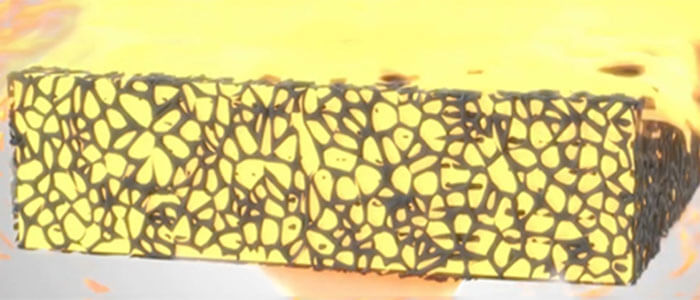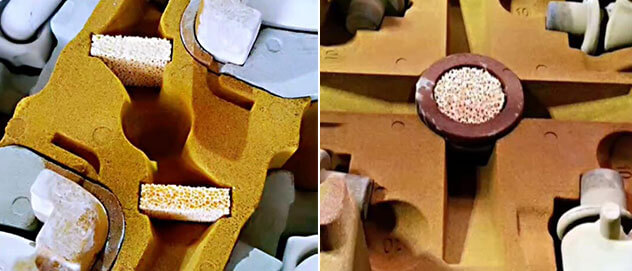As a high-performance casting filter material, zirconia (ZrO₂) ceramic foam filters are widely used in the purification of metal melts such as steel and high-temperature alloys. Its excellent high-temperature stability, chemical inertness and controllable pore structure can effectively remove non-metallic inclusions in the melt and significantly improve the quality of castings.
Introduction
In the casting production process, inclusions such as oxides, slag, and sand particles in the metal melt are one of the main reasons for the pores, cracks, and mechanical properties of castings. Although traditional filtering methods such as fiber mesh and straight-pore ceramic filters can partially remove impurities, their temperature resistance and filtration efficiency are still limited in high-temperature alloy casting or production with high cleanliness requirements.
Zirconia ceramic foam filters have become the preferred filtration solution for high-end castings such as aircraft engine blades, automotive aluminum alloy wheels, and precision steel castings due to their extremely high melting point (~2700°C), excellent thermal shock resistance, and controllable pore structure.

As a professional casting material supplier, SEFU optimizes the zirconia stabilization process and foam structure design to ensure that the filter maintains stable filtering performance in high temperature environments.
Characteristics of zirconia ceramic foam filters
High temperature stability
The melting point of zirconia is as high as 2700°C, which is particularly suitable for casting high-temperature alloys (such as nickel-based alloys and titanium alloys). Stabilization treatment by adding yttrium oxide (Y₂O₃) or magnesium oxide (MgO) can avoid phase change cracking of zirconia at high temperatures and ensure long-term stability.
Excellent thermal shock resistance
During the casting process, the contact between the molten metal and the filter will produce severe thermal shock. Partially stabilized zirconia can absorb thermal stress and reduce the risk of cracking through phase change toughening mechanism, and is suitable for repeated heating-cooling conditions.
High porosity and controllable filtration accuracy
The porosity of zirconia foam ceramics is usually between 70% and 90%, and the pore size range can be controlled at 10-30ppi (pores/inch), which is suitable for the filtration needs of different metals:
- Coarse filtration (10ppi): used for primary pouring, intercepting large particles of slag.
- Fine filtration (20-30ppi): suitable for thin-walled castings or alloys with high cleanliness requirements.
Chemical inertness
Zirconium oxide hardly reacts with molten metals such as aluminum, magnesium, copper, and steel, avoiding the contamination of the filter’s own material to the melt and ensuring precise control of the casting composition.
Preparation process of zirconia ceramic foam filters
High-purity zirconia powder is used to prevent volume changes caused by high-temperature phase changes and improve material life. The current mainstream preparation methods are mainly:
Organic foam impregnation method: immerse polyurethane foam into zirconia slurry, dry it, and sinter it at a high temperature of 1500-1700°C to fully combine the zirconia particles to form a high-strength porous ceramic skeleton to form a three-dimensional network structure.
Application of zirconia ceramic foam filters in casting
Zirconium oxide ceramic foam filters are usually installed in the following positions of the casting system:
- Between the pouring cup and the cross runner: used for primary filtration to intercept large particle inclusions.
- Inner runner or casting mold entrance: used for fine filtration to ensure that the metal liquid entering the mold cavity is pure.
Applicable metals and typical cases
- Used in automobile wheels and engine cylinders to reduce oxide inclusions and improve fatigue life.
- Steel casting: filter Al₂O₃ and SiO₂ in molten steel to reduce slag inclusion defects in castings.
- High-temperature alloy precision casting: such as nickel-based alloy turbine blades, to ensure that there are no impurities affecting high-temperature performance.
Conclusion
Zirconium oxide ceramic foam filters have become an indispensable purification material for high-end casting due to their excellent high-temperature performance and filtration efficiency. As the casting industry continues to improve its requirements for casting quality, optimizing filter structure and reducing production costs will be the main research direction in the future.
As a manufacturer of ceramic foam filters, SEFU will continue to promote technological innovation of zirconia foam ceramics and provide more reliable filtration solutions for global casting companies.


